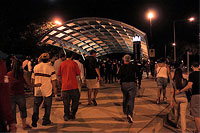Metro’s future rides on Saturday night
The builders of our Metro envisaged a railroad that would take commuters from scattered residential neighborhoods to jobs in a small downtown. Non-work trips by tourists and residents were expected, to be sure, but they were an afterthought. And sixteen years ago, a commuter railroad is essentially what we had.
In May 1995, nearly one trip of every ten carried a morning commuter to just five stations in what was then the downtown business district
Dupont Circle, Farragut North and West, McPherson Square, and Metro Center.
An equal number of trips took those commuters home. Federal office buildings were, of course, major destinations as well. Once the workday was over, trains were rarely crowded.
Today, we have a changed system.
Not only are there almost 50% more riders each week, but they take a very different mix of trips. Commuters still flock to offices in the old downtown, but they are not Metro’s future. In May 2010, fewer passengers exited Dupont Circle in the morning rush hour than in the same month of 1995. The two Farragut stations were up, but only by 5%. As a share of Metro’s total weekly ridership, morning commutes into the old downtown plummeted from 9.8% to 7.2%.
The biggest source of ridership growth is the emergence of new commuting destinations as the land around stations has been redeveloped. A new downtown blossomed between Gallery Place and Union Station while the federal buildings south of the Mall produced more riders, and reverse commutes to the suburbs soared.
But the real key to understanding Metro’s growth is found elsewhere: in the explosion in non-commuting trips by area residents. The best way to measure this is by looking at Saturday night travel. In 1995, 39,198 people entered the rail system after 7:00 Saturday night. By 2010, the number was 94,646. The increase of 142% dwarfs the 43% growth in weekday morning commutes.
Not only are more people riding on Saturday night, they are different people. The ten busiest Saturday-night stations are listed in the table. Back in 1995, tourists going home late were numerous enough to give Smithsonian tenth place on the list.
Today that station’s ridership has risen from 1830 to 2457, but it ranks 25th and is barely ahead of Fort Totten. Columbia Heights and U Street
have surged high on the list.
These busy Saturday nights are the key to understanding Metro’s ten years of growth. The root cause of ridership growth since the late 1990s has been increasing demand for an urban, transit-oriented lifestyle.
True, the majority of the added trips have been travel to work. But there has been little growth in Metro travel between existing homes and offices. Growth in Metro commuting has followed mixed-use development near the stations.
Transit-oriented development is, of course, market-driven. And what the market demands is the opportunity to take non-work trips on foot or by Metro. This can be seen clearly in Arlington’s Orange Line corridor from Courthouse to Ballston. Morning rush-hour travel from these stations increased only 20% from 1995 to 2010, less than the growth in population. Saturday night travel rose 165%.
In the nineties, you got an apartment in Ballston for an easy commute into DC Now, you live there because you want to be in the city but are stuck with a job in Tysons.
Last week, some WMATA staff and Board members suggested eliminating late-night rail service on Fridays and Saturdays to save money and facilitate maintenance. That is a cut Metro cannot afford, because it undercuts the future growth of all-day ridership.
New development is what has brought new riders, not increased mode share in existing markets. To cut back on what makes transit-oriented development appealing
would be to destroy Metro’s future.
Busiest Metro stations on Saturday night
(total entries and exits after 7:00 pm)
May 1995:
- Dupont Circle - 5,336
- Union Station - 5,169
- Foggy Bottom - 4,062
- Metro Center - 3,821
- Pentagon City - 3,399
- Stadium-Armory - 3,077
- Silver Spring - 2,501
- Woodley Park - 2,087
- Rosslyn - 1,905
- Smithsonian - 1,830
May 2010:
- Gallery Place - 14,060
- Dupont Circle - 11,119
- Foggy Bottom - 6,637
- U Street - 6,354
- Metro Center - 6,287
- Columbia Heights - 5,755
- Union Station - 5,669
- Pentagon City - 5,499
- Silver Spring - 4,803
- Woodley Park - 4,501

